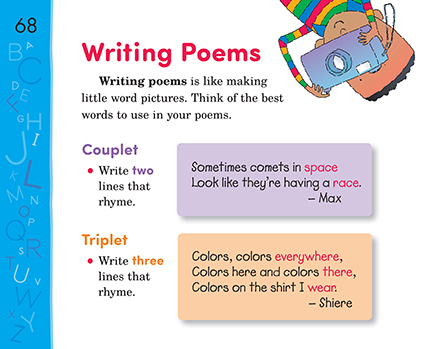Page 68 from

Start-Up Activity
Read and display favorite poems and discuss the concept of structure and rhyme. Also read “Rhyming Families” on pages 92–93. Write the word star and ask students to suggest words that rhyme with it. List them below. Then write the word bug and repeat the process. Afterward, read page 68 and choose two rhyming words to use in a couplet. (“You must go far / to catch a star!”) Have students then write their own couplets or triplets.
Enrichment Activity: Model the other forms covered in the chapter—quatrains, tongue twisters, cinquain, and list poems. Have students try each form. Create a special place in the classroom where students can display their poems.
Think About It
“I wrote my first poems and stories perched on a fire escape high above the backyards.”
—Sharon Bell Mathis

Start-Up Activity
Read and display favorite poems and discuss the concept of structure and rhyme. Also read “Rhyming Families” on pages 92–93. Write the word star and ask students to suggest words that rhyme with it. List them below. Then write the word bug and repeat the process. Afterward, read page 68 and choose two rhyming words to use in a couplet. (“You must go far / to catch a star!”) Have students then write their own couplets or triplets.
Enrichment Activity: Model the other forms covered in the chapter—quatrains, tongue twisters, cinquain, and list poems. Have students try each form. Create a special place in the classroom where students can display their poems.
Think About It
“I wrote my first poems and stories perched on a fire escape high above the backyards.”
—Sharon Bell Mathis